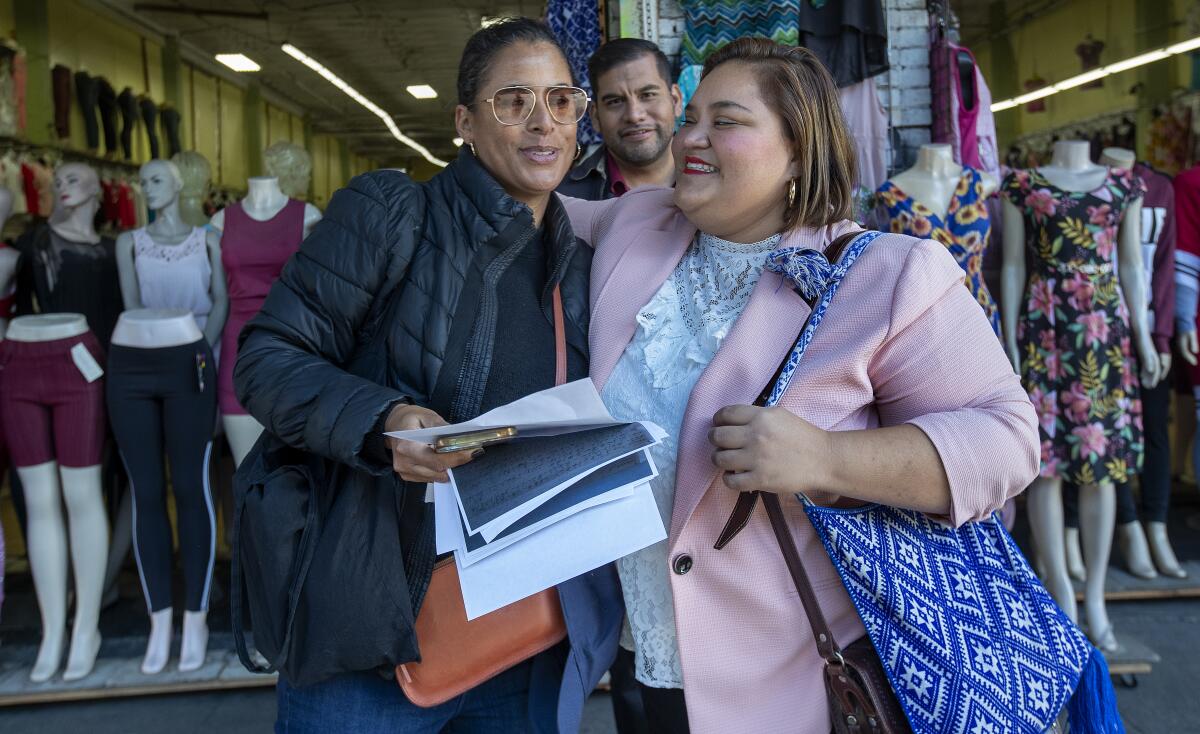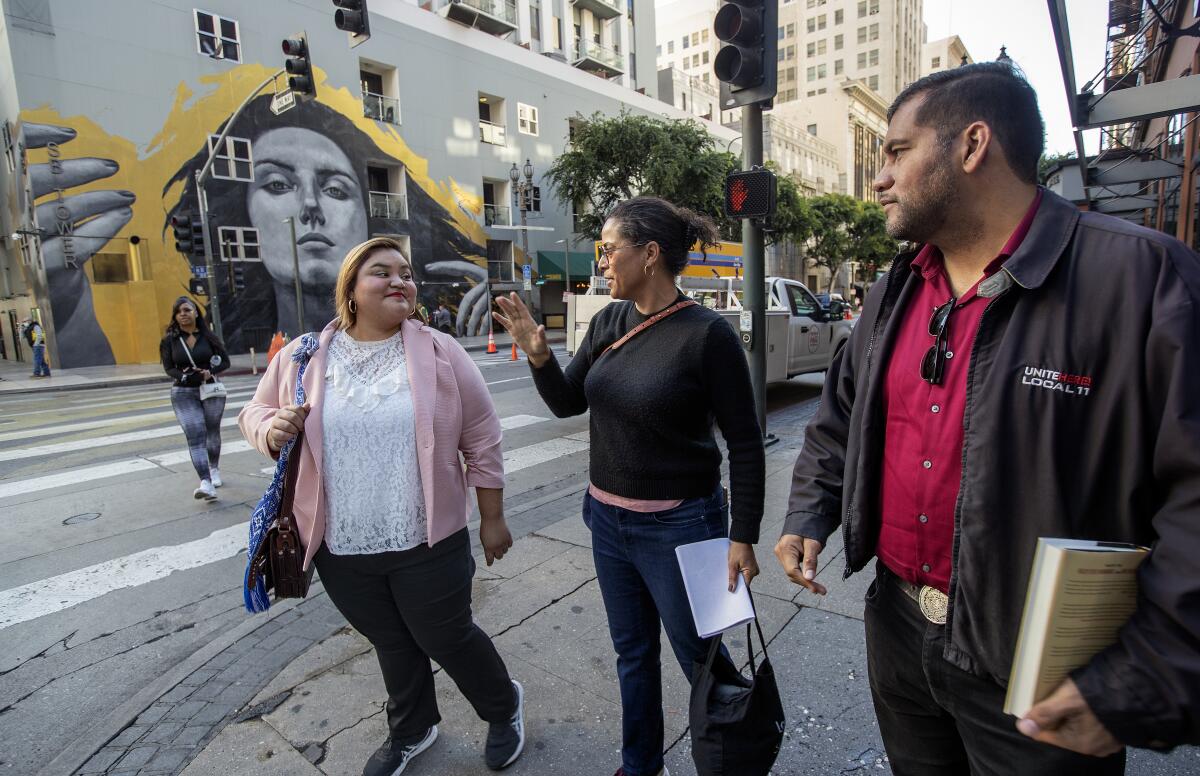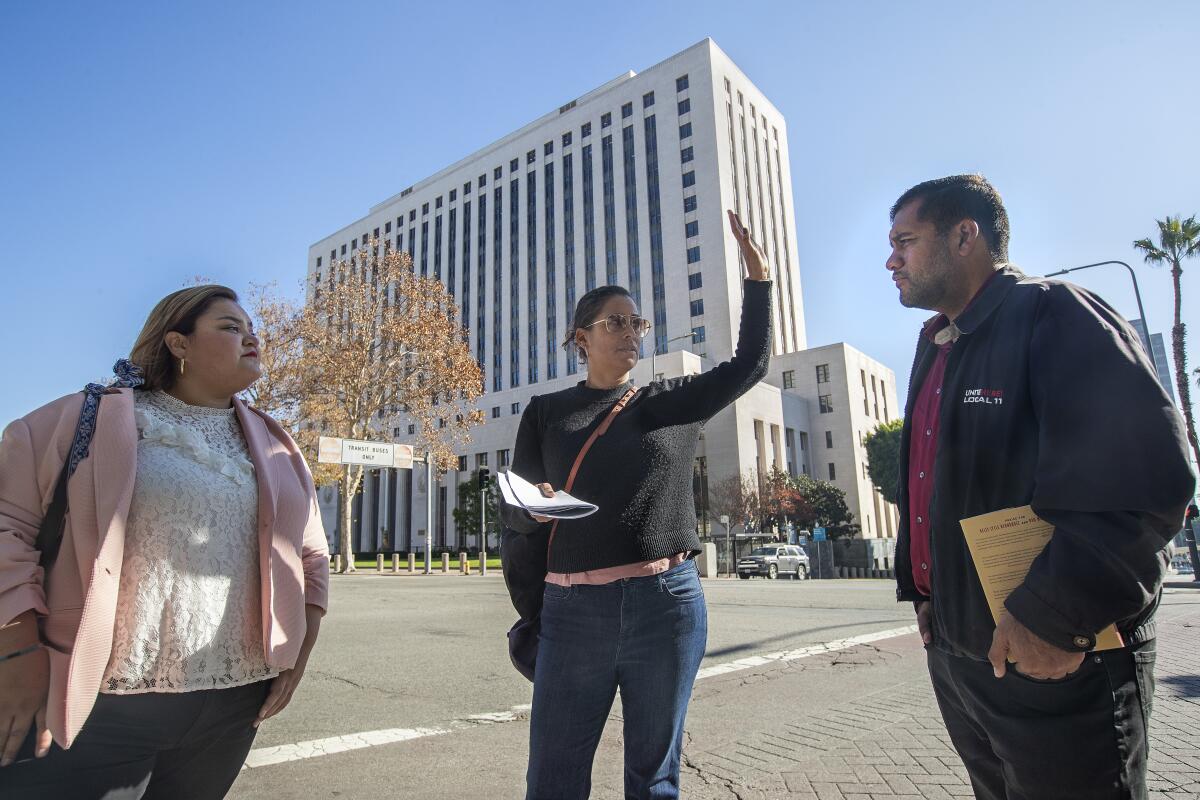Column: A tour of L.A.’s radical past with the city’s newest radical council members

In front of a row of mannequins, newly elected Los Angeles Councilmembers Eunisses Hernandez and Hugo Soto-Martinez pondered the city’s radical past, present and future.
They looked over photocopies of the secret codes of the Magonistas — activists whose writings and organizing helped spark the Mexican Revolution and forever changed the course of Mexican and U.S. history, especially in Southern California.
Hounded by authorities from the two countries, the Magonistas landed in L.A. in the 1900s. They lived and worked and rallied across the city, from skid row to Silver Lake to here in the Fashion District, where Soto-Martinez and Hernandez met me on a chilly Friday morning.
With us was UCLA history professor Kelly Lytle Hernandez. Her recent book “Bad Mexicans” tells the Magonista saga in cinematic detail. She explained how in 1907, the location where we stood was a hideout for Ricardo Flores Magón, the brilliant but problematic leader who lent his name to the Magonistas.
Lytle Hernandez, a MacArthur “genius” grant winner, was about to take us on a two-mile walk through Magonista L.A., ending at City Hall. I had asked her for a tour in the summer, but we couldn’t align our calendars.
In the wake of the elections of Hernandez and Soto-Martinez, unabashed progressives who beat incumbents with promises to bring people power to City Hall, I suggested that we try again. This time, we’d go with the incoming council members so Lytle Hernandez could share the Magonista story as both inspiration and cautionary tale.
“You see the resurgence of Latinx organizing right now, and Hugo and Eunisses come from that,” she told me shortly before the council members arrived. “They’re helping to change the city.”
The profe had an hour and a half for us — the typical span of an undergraduate lecture — before she caught a plane.
“Thank you for the work you’ve done and will do!” she told Hernandez and Soto-Martinez before handing them copies of her book. She asked if they had ever heard of the Magonistas. Vaguely, they replied.
“There’s only one American immigration story allowed, and it’s about assimilation,” Lytle Hernandez said. “But Mexican Americans also offer a story of resistance. The Magonistas are part of that story.”
On Sundays in the old days, the whole family gathered at the Southern California chicken ranch to hear the old man tell tales of the Mexican Revolution of 1910.
Magón and his brothers were journalists who fled their country after articles and columns they wrote against Porfirio Díaz, a former general who ruled as Mexico’s president for 31 years, landed them in prison.
Diaz convinced U.S. officials that the Magonistas posed a threat north of the border as well, so Magón lived as a revolutionary nomad until finally ending up in Los Angeles. He promptly began to publish his newspaper, Regeneración, and went after the Diaz regime harder than ever, selling copies across the American Southwest and Mexico.
The U.S. government doubled down on its surveillance. The code Lytle Hernandez shared with the council members was used by the Magonistas to write encrypted letters, and the feds were able to crack it. When two Latino police officers tracked Magón down, at the very spot where we stood, to arrest him and two other comrades for violating U.S. neutrality laws, they expected an easy capture, Lytle Hernandez said.
“It was a complete brawl!” she exclaimed. Magón’s neighbors rushed to pull him away from the officers, who finally dragged him, kicking and screaming, into a car and straight to the city jail.
“Which is the first official building in the city,” Hernandez responded.
Lytle Hernandez stopped and smiled. “You read the book!” she said, referring to her 2017 history of L.A.’s jail system, “City of Inmates.”
“I’m seeing this like a movie in my head,” Soto-Martinez added. He wore a jacket emblazoned with the logo of Unite Here Local 11, the labor union where he has been an organizer for more than a decade. Hernandez, a longtime community activist, carried a Oaxacan-style knitted bag. Everyone sported running shoes.

We made our way north on Main Street before merging onto Spring Street. Hernandez and Soto-Martinez walked on either side of Lytle Hernandez, who weaved in the disparate threads of the Magonistas to emphasize their intersectional strength. She mentioned the women who did a lot of thankless work and the Black folks who helped them along the way — contributions that never made it into archives but that Lytle Hernandez nevertheless unearthed. Magón’s hideout house? He found it through a Black real estate agent.
“You don’t show up to fight for someone,” Lytle Hernandez said, “unless you have community relationships. And you still see it in the city today.”
The names of old L.A. popped up everywhere we looked on century-old buildings that are now lofts or apartments or vacant. The Santa Fe Railroad. The Pacific Electric Company. Lankershim. Van Nuys.
As Lytle Hernandez explained how they and other American businessmen got fabulously wealthy from their Mexican properties, at the expense of Mexicans, Hernandez sarcastically snapped, “That’s gentrification at its finest” — a line that could’ve easily worked if she had remarked about all the hipster shops we passed, where working-class establishments once stood.
Lytle Hernandez took out clippings about the Magonistas from this paper. Our owner at the time, Harrison Gray Otis, held millions of dollars worth of property in Mexico and used The Times to demonize Magón and his followers at every chance.
“This is the thing,” Lytle Hernandez explained. “This [Magonista] history was all over the newspapers. But then it was suppressed.”
“Are there any plaques?” Soto-Martinez asked.
“Noooo,” Lytle Hernandez responded.
“They don’t want us to know it’s been done before,” Hernandez added. Lytle Hernandez nodded, then Soto-Martinez told his new colleague that they should look into official commemorations.
We stopped at the Alexandria Hotel, once the playground for L.A.’s elites.
Upon news of Magón’s arrest, “all the big dogs start throwing parties,” Lytle Hernandez said. The most extravagant one happened here, hosted by oil tycoon Edward Doheny. She then noticed a banner that read “Return to Elegance” outside the Alexandria’s locked doors.
“More like ‘Return to Empire,’” she cracked.
Magón kept organizing from the city jail, attracting people of all political persuasions who wanted to see Diaz defeated, “like the people who united against [former Los Angeles County Sheriff Alex] Villanueva,” Lytle Hernandez said.
But Magón’s uncompromising anarchist politics and humongous ego began to alienate followers. So did his outing of two women as lesbians in his newspaper, along with broadsides against Chinese migration to Mexico.
“We see the same person that uses the language to take down a dictator — he used the same language to strip down anyone who disagreed with him,” Lytle Hernandez said.
“It’s like two sides of the same coin,” Soto-Martinez noted.

We made our final stop at the intersection of Spring and Temple streets.
On one side was L.A. City Hall, where Soto-Martinez and Hernandez will be sworn in on Tuesday. On the other side was the Spring Street Courthouse, occupying the same block as an earlier federal courthouse where Magón and others were convicted in 1909.
Supporters jeered the prosecution, with little girls dressed in white throwing red carnations on the ground so the Magonistas could walk on them, Lytle Hernandez said.
Magón served three years before being released. He died in Leavenworth Penitentiary in 1922 at age 48 while serving a separate 20-year sentence for sedition.
By then, Diaz was long dead, and a new government looked at the Magonistas as the intellectual godfathers of the Mexican Revolution.
Lytle Hernandez concluded by emphasizing how their history, well-covered while it happened, was wiped from U.S. history books, even though Los Angeles played such a crucial role in the movement. But those ghosts never fully disappeared.
“You know there’s something that’s missing [as activists], but you don’t know what it is,” she said. “So what happens when you put that history back in? It’s this incredible history that we’ve been so severed from. But we can see each other in our movements. We can’t let them take us apart.”
“We have to learn the good, but also the bad,” Soto-Martinez added. “Lead with solidarity and think about the community we need to build.”
“We’re not reinventing the wheel,” Hernandez replied. “We’re just putting more air in a wheel that’s been going on.”
Lytle Hernandez hugged Hernandez and Soto-Martinez. Their eyes were large, their smiles radiant.
“Go get it!” the professor told them. “Rock the city.”
More to Read
Sign up for Essential California
The most important California stories and recommendations in your inbox every morning.
You may occasionally receive promotional content from the Los Angeles Times.











